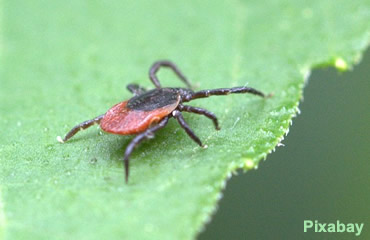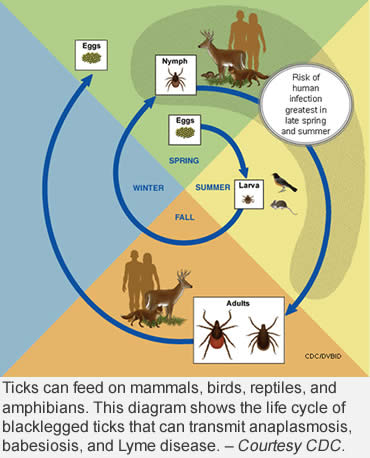Bloodsucker. It’s a vampire, a science fiction film, a song title, a comic book character. Or it’s a tick.
Ticks are uninvited, annoying and potentially health-risking creatures that land on you and your pets. They can carry a long list of tick-bite related diseases, such as Lyme Disease, Rocky Mountain spotted fever (RMSF) or Southern Tick–Associated Rash Illness (STARI) among many others.
Depending on where you live, the time of year and your activities, it is possible to avoid an encounter or tick bite for most of your life, but for hunters and people of all ages who are frequently outdoors, it’s unlikely.
A tick bite is serious thing—which is why the best offense is a good defense.
Start with prevention. Remember to use insect repellant, to wear long pants and long-sleeved shirts, to tuck your shirts into pants, and to tuck your pant legs into socks. When you leave the woods and before you return home, that’s the time to check for ticks.
 If your dog was with you, check your dog, too, even if your canine companion wears a flea and tick-repellant collar.
If your dog was with you, check your dog, too, even if your canine companion wears a flea and tick-repellant collar.
Removing a tick quickly remains the best approach, using a pair of tweezers. Saving the tick you removed is also a good idea, according to Lyme disease experts. Here’s how to do that.
Ticks aren't bugs or insects. They are relatives of spiders, arachnids—ectoparasites that live by feeding on the blood of mammals, or reptiles and amphibians.
Of the three most common ticks found in the US, the most prevalent is the large and slow-moving American dog tick. The Lone Star Tick is second most common. Smaller than the American dog tick, it has a longer mouth and takes a bigger bite. Third most common are black-legged ticks, also called deer ticks, These tiny oval-shaped ticks feed on mice, small rodents and white-tailed deer.
 Beau Brodbeck, an Alabama Extension agent in forestry, wildlife and natural resources said “ticks find their hosts by sensing breath, odor, heat, vibrations or shadows. They also find hosts by waiting or questing on the tips of grasses and shrubs along a well-used path.
Beau Brodbeck, an Alabama Extension agent in forestry, wildlife and natural resources said “ticks find their hosts by sensing breath, odor, heat, vibrations or shadows. They also find hosts by waiting or questing on the tips of grasses and shrubs along a well-used path.
“Game trails, especially deer trails are prime locations. Ticks cannot fly or jump, but when hosts brush past them, ticks can quickly climb onto clothing or fur. Once on the body, ticks find a preferred spot and start feeding. It is during feeding that a tick can transmit illnesses to the host.”
Lyme disease is the most commonly reported vector-borne illness in the United States, with approximately 300,000 cases reported per year.
Symptoms of Lyme disease, Rocky Mountain spotted fever and Ehrlichiosis usually appear within days or weeks after being bitten by an infected tick. Symptoms may resemble flu and include fever, headache, chills, stiff neck, fatigue, nausea, mental fogginess, swollen lymph nodes, muscle aches and joint pain.
Brodbeck says if you have been bitten by a tick and have these symptoms, see a doctor.
Finding an accurate diagnosis for a tick-borne disease often can be challenging. In 2015 during the Buckmasters Life Hunt Classic, hunter Carrie Lynn Mason, who was 19 at the time, was one such person. She never displayed classic symptoms of Lyme Disease, and initial blood tests indicated she was negative for Lyme Disease, yet her symptoms worsened. To read more about her brave fight with tick-borne disease, visit here.
Being aware and educating yourself about ticks and tick-borne diseases is must-have information for outdoors activities.
Learn more about ticks and tick-borne illnesses in an Alabama Extension fact sheet online.
Beau Brodbeck’s complete update, Beware of Ticks, is available by clicking here.
To learn more about the 16 separate tick-borne diseases found in the United States listed by the Center for Disease Control, click here.